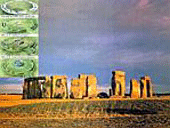Archeologists discover another Stonehenge in the Russian city of Ryazan
A 4 thousand years old construction found in Russia
 Two years ago, Russian archeologist Ilya Akhmedov made a sensational discovery: he found an ancient construction resembling the English Stonehenge near the site of ancient settlement of Staraya Ryazan (now this is a big Russian city), in the village Spasskaya Luka. It was estimated that the construction is 4 thousand years old. This discovery is smaller than the English analogue and is made of wood.
Two years ago, Russian archeologist Ilya Akhmedov made a sensational discovery: he found an ancient construction resembling the English Stonehenge near the site of ancient settlement of Staraya Ryazan (now this is a big Russian city), in the village Spasskaya Luka. It was estimated that the construction is 4 thousand years old. This discovery is smaller than the English analogue and is made of wood.
This is astonishing, but similar discoveries were later made all over Eurasia within the next two years. Not amateurs but rather experienced researchers discovered these ancient observatories. As a rule, all of these constructions are based upon the same principle: on the day of the summer and winter solstice the sunrays fall upon some definite spot of a sanctuary made of megalith stones or wood. This is strange that none of the researchers has made an attempt to compare these discovered observatories and find out their common principles.
In June 2005, a new expedition of astronomers headed by journalist and orientalist Andrey Polyakov left for Staraya Ryazan. The researcher is known for his expeditions to Ararat and Nakhichevan in search of Noah’s Ark.
The sanctuary near Staraya Ryazan is situated on the highest hill in the junction of the rivers Oka and Pronya. The area is unique for the great variety of cultures presented there: from the upper paleolith to the early Middle Ages. The previous expedition in 1979 was very close to discovering the sanctuary but failed to find it.
The construction is a circle of seven meters in diameter hedged in with wooden columns each is half a meter thick, at the same distance from each other. There is a large rectangular hole in the center of the circle and a pole. The wooden columns were destroyed but one can clearly see the round holes where they used to stand.
Ilya Akhmedov says that there are two more holes with poles on the ends of the ground. Two more holes of this type situated eastward and in the south were discovered around the area, the researcher says.
Within the circle, two couples of the poles form some type of gates through which one can see the sunset in the summer. Another pole outside the circle points at the sunrise. Archeologists discovered a small ceramic vessel with a delicate design on it: short lines make a zigzag resembling sunrays and wavy lines on the top symbolize water. The vessel belongs to the bronze epoch. In 2003, archeologists made a conclusion that the pagan temple was connected with astronomy; there were no settlements close to the place, all inhabited places were located some distance away from the discovery.
Andrey Polyakov says that it is bad for health to get settled at the junction of rivers. But at the same time, this place situated away from settlements suited well for rituals and observatories. Indeed, no settlement was discovered close to Ryazan’s Stonehenge, at the time when discoveries of everyday articles such as ceramics and adornments were abundant in the area.
Church constructions in Staraya Ryazan suggest that the ancient observatory is situated far from the settlement, as the Orthodox Church traditionally built its cathedrals away from pagan temples.
Slavic tribes came to the junction of the rivers Pronya and Oka in the 10-11th centuries where the city of Ryazan appeared in about 1096. But the city was burnt to the ground by Mongol barbarians in 1237; and the city was never reconstructed completely. In the 18th century, the city Pereyaslavl Ryazansky was called Ryazan and this is the contemporary city the Russians know.
It is not clear for how long the pagan temple stood in Spasskaya Luka. Unfortunately, no archeological digging is allowed in Staraya Ryazan starting with 2005. Locals say that some company is going to build a recreation center in the area.
Subscribe to Pravda.Ru Telegram channel, Facebook, RSS!




